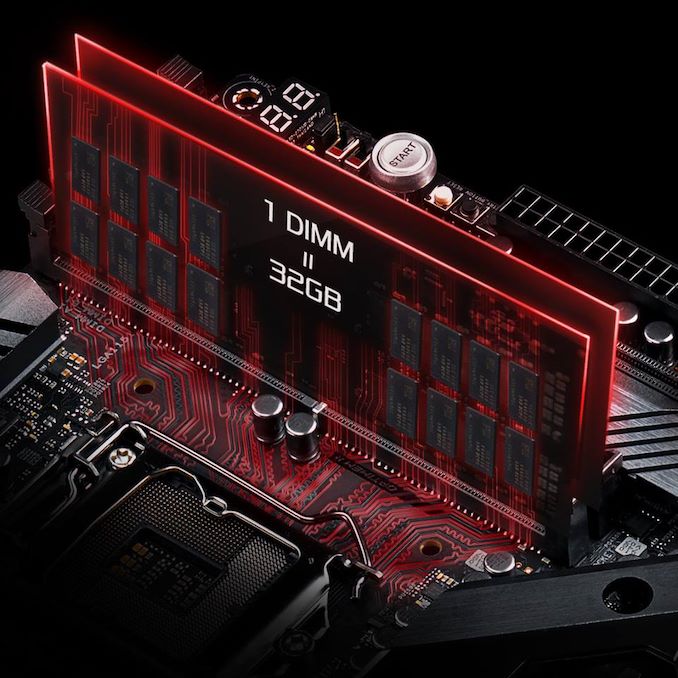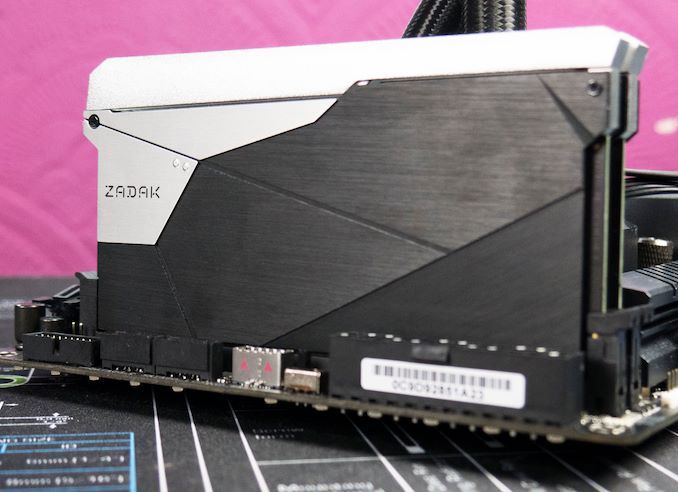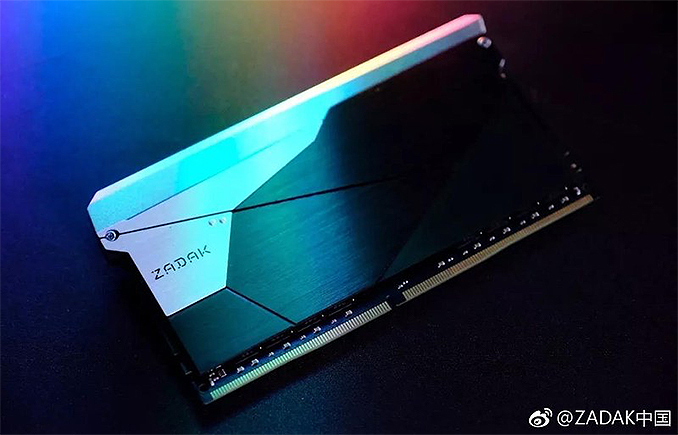Double Height DDR4: 32GB Modules from G.Skill and ZADAK Reviewed
by Ian Cutress & Gavin Bonshor on January 23, 2019 9:00 AM ESTZADAK Shield RGB DC DDR4-3200 Overview
We first learned about the new ZADAK 32 GB modules back in September. Since then, ZADAK has announced a total of five different 2x32GB Shield RGB DC kits in four different clock speeds, from DDR4-2666 through to DDR4-3600. There are two kits available at DDR4-3200 with different latencies; at CL14-14-14-34 and with slightly looser secondary and tertiary timings of CL14-16-16-36. All of these kits are compatible with three specific ASUS ROG Z390 models: the STRIX Z390-I Gaming, MAXIMUS XI APEX and MAXIMUS XI Gene.
For this review, we received a kit of the DDR4-3200 CL14-16-16-36. This dual channel 64 GB (2x32 GB) kit has an operating voltage of 1.35 V and features Samsung B-Die ICs. By contrast to ZADAKs other kits on the market, this is quadruple the capacity of its 8 GB UDIMMS.

ZADAK Shield RGB DC Memory in an ASUS Z390 Motherboard
While we know the ZADAK Shield RGB DC memory has a total of 32 memory ICs on its PCB (16 on each side), and it uses a similar pin-out implementation to G.Skill, leading to the specialization that they only work on select ASUS motherboards that have been validated. Unfortunately the ZADAK headspreader is firmly bonded to the chips, meaning removing the headspreader has a chance that it could remove a chip; we were unable to secure any images from ZADAK for underneath the heatspreaders, so at this point we are assuming that they work similarly to the G.Skill modules with double EPROMs onboard and act as two DIMMs on one PCB.
Analyzing at the mechanical design of the ZADAK Shield RGB DC DDR4-3200 memory, they are 73 mm in height which isn't much taller than ZADAKs own 8 GB Shield RGB memory which have a height of 60 mm. This means the heatsinks extend quite a bit further than the PCB with the majority of the height coming as a result of the integrated RGB LED lightbar. The heatsinks feature a three-tone design with black, grey and silver aluminium heat spreaders. The effect is not as pronounced as the G.Skill RGB light bar.
The RGB LEDs built-into the top of the heat spreader is addressable and can be customized with ASUS AURA software.
ZADAK in itself is an arm of Apacer Technology who formed back in 1997 as a DRAM supplier. ZADAK formed in 2015, and would prefer to be identified as a separate entity from Apacer, similar to how HyperX is to Kingston, or Crucial is to Micron.
Using the Taiphoon Burner DRAM software, we can see the JEDEC DIMM Label is listed as 16 GB of 2Rx8. This means the sensor is showing that each module is organised by the firmware into two lots of 16 GB and not one of 32 GB. The latency timings of the XMP 2.0 profile are 14-16-16-36.
ZADAK has better market variation with a total of five different kits.
The baseline model is a DDR4-2666 kit which is the cheapest of the five models at $799 and has timings of 16-16-16-36. This is relatively slow in terms of latency timings for a kit of this speed overall, but so far its the only DC kit from any vendor to operate at just 1.2 V on its XMP 2.0 profile.
Stepping up to the next mark is a DDR4-3000 kit with slightly slower timings of 16-16-18-38 for $899 and operates at 1.35 V. There are two DDR4-3200 kits available with both kits having the tightest timings, and a final DDR4-3600 kit. This DDR4-36000 kit has an MSRP of $1299 USD which is $500 premium over the DDR4-2666 base model which is a considerable chunk of budget for a desktop platform.
| ZADAK Shield RGB DC Kits for ASUS Z390 Platform | |||||||
| Speed | CL Timing | Voltage | Kit Config. |
PN | MSRP (USD) |
||
| DDR4-2666 | CL16 16-16-36 | 1.20 V | 2×32 GB | - | $799 | ||
| DDR4-3000 | CL16 16-18-38 | 1.35 V | - | $899 | |||
| DDR4-3200 | CL14 14-14-34 | - | $1199 | ||||
| CL14 16-16-36 | ZD4-SHC3200C14-32GCS | $999 | |||||
| DDR4-3600 | CL16 18-18-38 | - | $1299 | ||||
The DDR4-3200 kit which we received for testing has slightly looser timings of CL14 16-16-36 and has a price of $999.
The current availability in retail channels of the ZADAK Shield RGB DC 2x32 GB kits is limited to Japan, China and Australia. ZADAK has stated that its DC kits will be available in Vietnam and Thailand during January, while the kits are planned for launch in the US and EU during Q1 2019.















50 Comments
View All Comments
CheapSushi - Wednesday, January 23, 2019 - link
I honestly really love it aesthetically. It makes the rest of the motherboard balance out Z-height wise with PCIe cards. I know nobody else cares but there's something about it that I like. It's also an interesting solution; reminds me of early OCZ PCIe SSDs with dozens of chips on them. I would honestly love if these worked on quad and deca DIMM slot boards.SmCaudata - Wednesday, January 23, 2019 - link
I was pressed for time upon initial scanning and jumped to conclusion. Then I dug a bit deeper. In the conclusion you state that the G.Skill is substantially larger while the other only has a marginal height difference. This makes the ZADAK sound smaller, when in fact, the G. Skill double is actually the same size as the ZADAK single.G.Skill 45 mm height up to 60 for the double
ZADAK 60 mm height up to 73 for the double
Anyway. Based on percentage of size increases, yes, the G.Skill grew more, but you may want to consider some clarity in your description as there are a lot of people that just read the conclusion and may be concerned about size.
DanNeely - Wednesday, January 23, 2019 - link
I was confused too, because the ZADAK dimms looked significantly larger than the G.Skill.DigitalFreak - Wednesday, January 23, 2019 - link
This proprietary solution is pretty much DOA now that true 32GB DIMMs are supported by Intel on Z390 systems. All it needs is a BIOS update.nevcairiel - Wednesday, January 23, 2019 - link
Clearly the base technology would also scale up to using 16Gb dies for 64GB in one DIMM. The argument for small systems with only two slots still exists.The_Assimilator - Wednesday, January 23, 2019 - link
The number of people who want/need 64GB on a 2-DIMM-slot motherboard can be counted in the thousands, maybe. The number of people who want/need 128GB on a 2-slot motherboard can be counted on your fingers. This is a product without a market.yuhong - Wednesday, January 23, 2019 - link
The DDR4 spec only goes up to 16Gbit though.rocky12345 - Wednesday, January 23, 2019 - link
Great write up thank you.It also makes me see how much I need to upgrade my own system because I am still on DDR3@2200MHz with tight timings though but still I am sure this is holding me back a lot. My Aidia 64 latency score is like 42ns-43ns and I also thought that was fairly good and would help me get better responsiveness in my games and maybe it does. Like I said though my 2200MHz is probably really on the slow side when you think of DDR4@3200MHz and higher being able to push the systems so much harder.
Targon - Wednesday, January 23, 2019 - link
Why not test these on an AMD Ryzen based motherboard or two and see if they will work? Just because things are only officially supported on one platform or another doesn't always mean that they won't work. Also, Intel vs. AMD is very different in terms of memory support, and while it is more difficult to get DDR4 3633 and above working on the AM4 platform, if it works, it works. 3200 isn't a difficult speed at this point.Targon - Wednesday, January 23, 2019 - link
I disagree with the final paragraph where the focus is for SFF and motherboards with only two memory slots. If you have four memory slots and you can install 32GB in each slot, 128GB of RAM might be important for some people. What if you have a motherboard with more slots, if you really want/need the RAM and this stuff works, it doubles the allowed amount of RAM on the motherboard.The official specs for what a MOTHERBOARD supports are often limitations of the technology of the time. How many old machines said "Max 4GB RAM", because there were two slots, and at the time, you never saw 4GB memory modules. I've gone back to some of those old machines, and used 4GB modules to give 8GB of RAM in a machine that theoretically could only take 4GB.